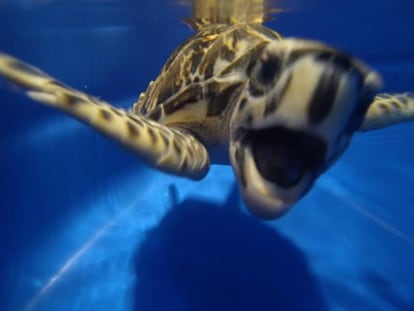Hawksbill turtles snap back from extinction
Marine biologists report growing numbers of nests along Central America’s Pacific coast

They are hidden among the rocks and have grown accustomed to their unusual muddy habitats. But just 10 years ago, marine biologists warned that the hawksbill sea turtle was practically extinct.
For decades, humans have sought their eggs – considered an aphrodisiac delicacy in many parts of Central America and the Caribbean – and their spotted turtle shells for jewelry, combs, brushes and other expensive fashion items.
But with the help of marine biologists and ecological experts – armed with a raft of international protectionist laws – the hawksbill (or carey, in Spanish) sea turtle is reappearing in numbers and putting smiles on the faces of conservationists who care for these creatures in the American tropics.
Once considered to be abundant, the turtles became endangered. But now they are listed as a promising species, even though they are threatened by overfishing techniques, including trawling.
People thought they were extinct, but now there’s hope”
“People thought they were extinct, but now there’s hope,” explains Alexander Gaos, a US biologist who specializes in the hawksbill. During a conference at Costa Rica’s National University in San Jose Thursday, Gaos explains how in 2007 his colleagues mocked him when he announced that he wanted to conduct research into hawksbill populations.
They were just about to be written off along with the dinosaurs until Gaos embarked on his research finding budding populations along the Pacific Coast, from Mexico to as far down south as Ecuador.
He is now optimistic because he has found at least 500 nesting females in the far corners of the Pacific, especially off the Central American coast. In the Caribbean, their number are also growing but at a slower rate.
Romantically speaking, they are beautiful turtles"
The hawksbill is still listed as “a critically endangered species,” but Gaos’ findings are good news considering that scientists just a decade ago believed they would soon disappear off the face of the Earth.
During the conference, Gaos warned about the dangers still facing the turtles, which frequently stay within their habitat and live in shallow coastal waters around underwater rocks and coral reefs.
The American biologist recalled a meeting between his colleagues and fishermen in El Salvador in 2004 when one person took the microphone and admitted – in an almost embarrassed tone – that only 120 nests could be found annually in his country. The figure was the best news in years for the marine biologists who consider the Salvadoran bay of Jaquillisco, as well as the Padre Ramos estuary in Nicaragua, one of the major nesting grounds for the hawksbill in Central America.
Lower but promising numbers of nests have also been found in Los Cóbanos, on the Salvadoran coast, and Aserradero in Nicaragua. Scientists hope that the levels will also rise in the island of Pelada, off the Pacific north coast of Costa Rica, which has strict laws prohibiting the sale of hawksbill eggs.
At the Costa Rican-Panamanian border, the hawksbill’s beaklike mouth is sold for cockfights: the owners put them on the bird’s own beak.
“Romantically speaking, they are beautiful turtles,” said Randall Arauz, a biologist at Pretoma, a Costa Rican non-profit marine conservation and research organization. “But in biological terms, their recovery would be great news because they feed on marine sponges that compete with underwater coral reefs. The coral reefs are vital habitats for other marine animals.”
Pretoma works closely with Gaos’ own NGO, Eastern Pacific Hawksbill Initiative (Icapo) and Widecaste-Costa Rica, the group where murdered environmentalist Jairo Mora worked. Mora’s tortured body was found on a beach in Costa Rica last year; turtle-egg poachers were blamed for his murder.
Tu suscripción se está usando en otro dispositivo
¿Quieres añadir otro usuario a tu suscripción?
Si continúas leyendo en este dispositivo, no se podrá leer en el otro.
FlechaTu suscripción se está usando en otro dispositivo y solo puedes acceder a EL PAÍS desde un dispositivo a la vez.
Si quieres compartir tu cuenta, cambia tu suscripción a la modalidad Premium, así podrás añadir otro usuario. Cada uno accederá con su propia cuenta de email, lo que os permitirá personalizar vuestra experiencia en EL PAÍS.
¿Tienes una suscripción de empresa? Accede aquí para contratar más cuentas.
En el caso de no saber quién está usando tu cuenta, te recomendamos cambiar tu contraseña aquí.
Si decides continuar compartiendo tu cuenta, este mensaje se mostrará en tu dispositivo y en el de la otra persona que está usando tu cuenta de forma indefinida, afectando a tu experiencia de lectura. Puedes consultar aquí los términos y condiciones de la suscripción digital.
Últimas noticias
Most viewed
- Reinhard Genzel, Nobel laureate in physics: ‘One-minute videos will never give you the truth’
- Oona Chaplin: ‘I told James Cameron that I was living in a treehouse and starting a permaculture project with a friend’
- Pablo Escobar’s hippos: A serious environmental problem, 40 years on
- Charles Dubouloz, mountaineering star, retires at 36 with a farewell tour inspired by Walter Bonatti
- Why we lost the habit of sleeping in two segments and how that changed our sense of time








































